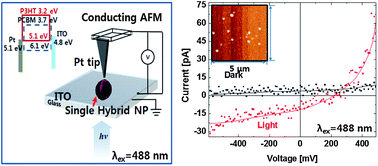Single nanoparticle of organic p-type and n-type hybrid materials: nanoscale phase separation and photovoltaic effect†
Abstract
We fabricated hybrid

* Corresponding authors
a
Department of Physics, Korea University, Seoul, Korea
E-mail:
jjoo@korea.ac.kr
Fax: +82-2-927-3292
Tel: +82-2-3290-3103
b Department of Physics, University of Incheon, Incheon, Korea
c Department of Chemical and Biological Engineering, Korea University, Seoul, Korea
We fabricated hybrid

 Please wait while we load your content...
Something went wrong. Try again?
Please wait while we load your content...
Something went wrong. Try again?
Y. Lee, S. H. Lee, K. Kim, J. W. Lee, K. Han, J. Kim and J. Joo, J. Mater. Chem., 2012, 22, 2485 DOI: 10.1039/C1JM13952E
To request permission to reproduce material from this article, please go to the Copyright Clearance Center request page.
If you are an author contributing to an RSC publication, you do not need to request permission provided correct acknowledgement is given.
If you are the author of this article, you do not need to request permission to reproduce figures and diagrams provided correct acknowledgement is given. If you want to reproduce the whole article in a third-party publication (excluding your thesis/dissertation for which permission is not required) please go to the Copyright Clearance Center request page.
Read more about how to correctly acknowledge RSC content.
 Fetching data from CrossRef.
Fetching data from CrossRef.
This may take some time to load.
Loading related content
